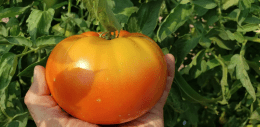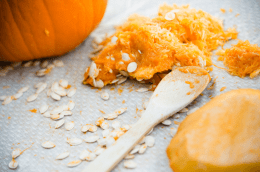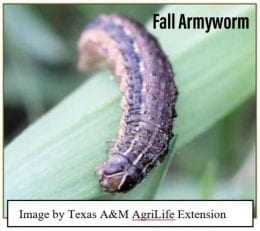Telling when a melon is ready to be harvested can be a challenge, or it may be quite easy. It all depends on the type of melon.
Let’s start with the easy one. Muskmelons are one of those crops that tell you when they are ready to be picked. This can help you not only harvest melons at the correct time but also choose good melons when shopping.
 As a melon ripens, a layer of cells around the stem softens so the melon detaches easily from the vine. This is called “slipping” and will leave a dish shaped scar at the point of stem attachment. When harvesting melons, put a little pressure where the vine attaches to the fruit. If ripe, it will release or “slip.”
As a melon ripens, a layer of cells around the stem softens so the melon detaches easily from the vine. This is called “slipping” and will leave a dish shaped scar at the point of stem attachment. When harvesting melons, put a little pressure where the vine attaches to the fruit. If ripe, it will release or “slip.”
When choosing a melon from those that have already been harvested, look for a clean, dish shaped scar. Also, ripe melons have a pleasant, musky aroma if the melons are at room temperature (not refrigerated).
Watermelons can be more difficult and growers often use several techniques to tell when to harvest.

- Look for the tendril that attaches at the same point as the melon to dry and turn brown. On some varieties this will need to be completely dried before the watermelon is ripe. On others it will only need to be in the process of turning brown.
- The surface of a ripening melon develops a surface roughness (sometimes called “sugar bumps”) near the base of the fruit.
- Ripe watermelons normally develop a yellow color on the “ground spot” when ripe. This is the area of the melon that contacts the ground.
By: Cassie Homan


 As a melon ripens, a layer of cells around the stem softens so the melon detaches easily from the vine. This is called “slipping” and will leave a dish shaped scar at the point of stem attachment. When harvesting melons, put a little pressure where the vine attaches to the fruit. If ripe, it will release or “slip.”
As a melon ripens, a layer of cells around the stem softens so the melon detaches easily from the vine. This is called “slipping” and will leave a dish shaped scar at the point of stem attachment. When harvesting melons, put a little pressure where the vine attaches to the fruit. If ripe, it will release or “slip.” and turn brown. With some varieties this tendril will need to be completely dried before the watermelon is ripe whereas others it will only need to be in the process of turning brown.
and turn brown. With some varieties this tendril will need to be completely dried before the watermelon is ripe whereas others it will only need to be in the process of turning brown.


 October is a good time to plant garlic if you want large quality cloves next summer. Apply 3 pounds of 10-10-10 fertilizer per 100 square feet and mix into the soil before planting or fertilize according to soil test. Plant individual cloves point up and spaced 6 inches apart and 1 to 2 inches deep. The larger the clove planted, the larger the bulb at harvest. Water in well and mulch with straw to conserve soil warmth and encourage good establishment.
October is a good time to plant garlic if you want large quality cloves next summer. Apply 3 pounds of 10-10-10 fertilizer per 100 square feet and mix into the soil before planting or fertilize according to soil test. Plant individual cloves point up and spaced 6 inches apart and 1 to 2 inches deep. The larger the clove planted, the larger the bulb at harvest. Water in well and mulch with straw to conserve soil warmth and encourage good establishment.